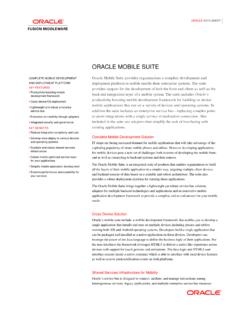Transcription of Architectural considerations while developing Enterprise ...
1 International Journal of Scientific and Research Publications, Volume 4, Issue 3, March 2014 1 ISSN 2250-3153 Architectural considerations while developing Enterprise Mobile Applications Suhas Bhosale*, Monali Bhosale** *Senior Technology Specialist, Extentia Information Technology, India **MCA Department, Abhinav Education Society s Institute of Management and Research, Pune, India. Abstract- Today s competitive environment is demanding employees to be productive on the way. Employees can work while at home, travelling or from on-site. Mobile devices are proving to be extremely helpful in increasing productivity of employees.
2 Enterprise Mobility is becoming an inevitable part of any organization and is playing crucial role in development of any organization. This paper is focused on discussing various aspects of Enterprise Mobile Application Development from an Architectural perspective. Index Terms- Enterprise Mobile Applications, Enterprise Mobility, Mobile Application Architecture, Go Mobile I. INTRODUCTION n the present era of mobile, deciding the mobility strategy is gaining a lot of attention for any organization. In a broader sense the mobile applications can be classified as: 1) B2C (Business to Consumer) Applications 2) B2B (Business to Business) Applications A.
3 Business to Business (B2B) Applications Business to Business (B2B) applications mainly focusses on various interactions viz. transactions between the businesses. B2B applications also defines the communication and collaboration between the various business units. B2B applications also caters employee needs to connect/interact with each other across/within various business units to fulfil the business needs. B. Business to Consumer (B2C) Applications Business to Consumer (B2C) applications mainly falls into Retail Mobile Application domain. Retail is considered as a sale from a business to its end-user consumer.
4 B2C applications are targeted towards creating virtual market place where business and consumer can exchange goods/services against the compensation. Another classification of mobile applications is based on the type of services provided by the respective mobile application. The mobile applications are classified as 1) Enterprise Mobile Applications 2) Consumer Mobile Applications A. Enterprise Mobile Applications Enterprise Mobile applications are designed for an organization and are focusing on addressing the business needs of an organization. The Enterprise mobile application may interact with the existing system to pull/push data to/from the system.
5 The typical tasks carried out by Enterprise Mobile system can be procurements. Order processing, Viewing Reports, On-Site reporting, Real Time data gathering (may be data processing in some cases, though the processing of data can be limited by the processing power of mobile device). Within a particular organization, the Enterprise Mobile Applications can be used by various departments like: Sales, Marketing, Production, Higher Management, etc. The Enterprise Mobile Applications can be related with Enterprise Resource Planning (ERP), Business Intelligence (BI) and Customer Relation Management (CRM).
6 Many organizations prefer to adapt suitable MEAP (Mobile Application Development Platform) to build mobile applications. B. Consumer Mobile Applications Consumer Mobile Applications are mainly focused on end customer. These types of applications mostly provided services based related with user location, Social Media, mobile commerce, etc. Generally these are the mobile applications which provides context-aware services. These apps mainly focused on user interests, likings, geo-graphical location, user intentions, user time zone, etc.
7 II. THE NEED OF Enterprise MOBILE APPLICATIONS AND STEPS TO GO MOBILE FOR Enterprise The mobile revolution which was started by Apple in 2007 after launching of iPhone has totally changed the face of mobile spectrum. It has generated the Going Mobile need for Enterprise to be in and lead the competitive market. Mobile has proven to be very effective way for an Enterprise to extend its services to large amount of consumers. Every organization is striving to improve the way in which the services are delivered to employees and end customers. The main focus is on accelerating the employee productivity and enhancing the end-user experience.
8 CIOs of companies are having mobility on their high priority list. Every Enterprise is looking for building their own presence in mobile spectrum. The following are the steps for any organization willing to Go Mobile 1) Define Mobile Strategy 2) Develop mobile application Strategy I International Journal of Scientific and Research Publications, Volume 4, Issue 3, March 2014 2 ISSN 2250-3153 3) Development, Deployment and Management of mobile applications A. Defining Mobile Strategy A Mobile strategy is a plan devised in order to decide / create / improve mobile presence of any organization.
9 A typical mobile strategy is based on some factors and answers to some of the below questions. 1) What are the problems faced by employees and end customers presently? 2) How Going Mobile can address their problems? 3) Which all sections of Enterprise needs mobility? 4) What are the applications needed in Business to Business (B2B) and Business to Consumer (B2C) categories? 5) What application strategy is needed for Business to Business (B2B) and Business to Consumer (B2C) applications? 6) Does Enterprise have backbone (mobile network infrastructure) in place for mobility support or Enterprise need to build mobile network infrastructure?
10 7) In case backbone is available, is that capable of serving mobile applications or Enterprise need some modifications to it? 8) Does the staff is literate enough to use mobile applications or Enterprise need to educate them? 9) If the training to staff is required, what will be the level of training is required? 10) What is the mobile usage index in the geographical areas where the end customer is based? 11) Does organization will provide mobile devices to the employees or organization is willing to follow BYOD (Bring Your Own Device) policy? 12) What MDM (Mobile Device Management) methodology Enterprise need to follow in order to maintain the security/authorization for Enterprise data?











![Abstract arXiv:1807.11626v2 [cs.CV] 18 Apr 2019](/cache/preview/e/0/4/1/a/c/1/c/thumb-e041ac1c39cfe74fb7b97fc619249da8.jpg)

